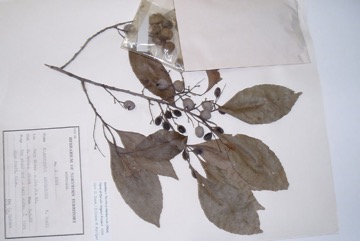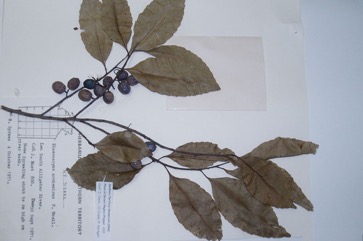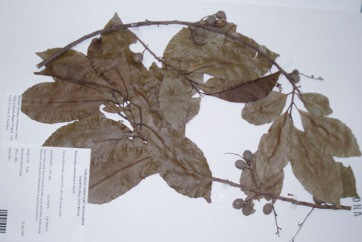Arnhem Land quandong, Bony Quandong

A tropical plant. It is native to N Australia and Papua New Guinea. Plants grow naturally along stream banks in tropical places. They extend into drier areas. It often grows in rocky areas. It needs a sunny position and a well drained soil. It can tolerate some frost. It is very tolerant of drought and salt. In tropical Queensland it grows between sea level and 1000 m altitude.
Also known as:
Dirndirnda
Edible Portion
- Fruit
Where does Arnhem Land quandong grow?
Found in: Australia, Pacific, Papua New Guinea, PNG
Notes: There are about 360 Elaeocarpus species mostly in the tropics.
Growing Arnhem Land quandong, Bony Quandong
Cultivation: Plants are grown from seed. Seed do not germinate regularly. Plants can also be grown from cuttings.
Edible Uses: The ripe fruit is eaten raw.
Production: In Australia fruit mature November to January.
Nutrition Info
per 100g edible portion| Edible Part | Energy (kcal) | Protein (g) | Iron (mg) | Vitamin A (ug) | Vitamin c (mg) | Zinc (mg) | % Water |
|---|---|---|---|---|---|---|---|
| - | - | - | - | - | - |
Arnhem Land quandong, Bony Quandong Photos



References
Barwick, M., 2004, Tropical and Subtropical Trees. A Worldwide Encyclopedic Guide. Thames and Hudson p 161
Brock, J., 1993, Native Plants of Northern Australia, Reed. p 147
Cherikoff V. & Isaacs, J., The Bush Food Handbook. How to gather, grow, process and cook Australian Wild Foods. Ti Tree Press, Australia p 199
Coode, M.J.E., in Henty, E.E., (Ed.), 1981, Handbooks of the Flora of Papua New Guinea, Melbourne University Press, p 93
Cooper W & Cooper W T, 1994, Fruits of the Rain Forest. RD Press p 104
Cooper, W. and Cooper, W., 2004, Fruits of the Australian Tropical Rainforest. Nokomis Editions, Victoria, Australia. p 159
Elliot, W.R., & Jones, D.L., 1984, Encyclopedia of Australian Plants suitable for cultivation. Vol 3. Lothian. p 384
Jackes, B.R., 2001, Plants of the Tropics. Rainforest to Heath. An Identification Guide. James Cook University. p 51
Jones D, L, 1986, Ornamental Rainforest Plants in Australia, Reed Books, p 141
Lazarides, M. & Hince, B., 1993, Handbook of Economic Plants of Australia, CSIRO. p 88
Levitt, D., 1981, Plants and people. Aboriginal uses of plants on Groote Eylandt. Australian Institute of Aboriginal Studies, Canberra. p 93
Low, T., 1991, Wild Food Plants of Australia. Australian Nature FieldGuide, Angus & Robertson. p 91
Morley, B.D., & Toelken, H.R., (Eds), 1983, Flowering Plants in Australia. Rigby. p 120
Scarth-Johnson, V., 2000, National Treasures. Flowering Plants of Cooktown and Northern Australia. Vera Scarth-Johnson Gallery Association. Cooktown, Australia. p 116
Townsend, K., 1994, Across the Top. Gardening with Australian Plants in the tropics. Society for Growing Australian Plants, Townsville Branch Inc. p 174
Williams, K.A.W., 1999, Native Plants of Queensland Volume 4. Keith A.W. Williams North Ipswich, Australia. p 172